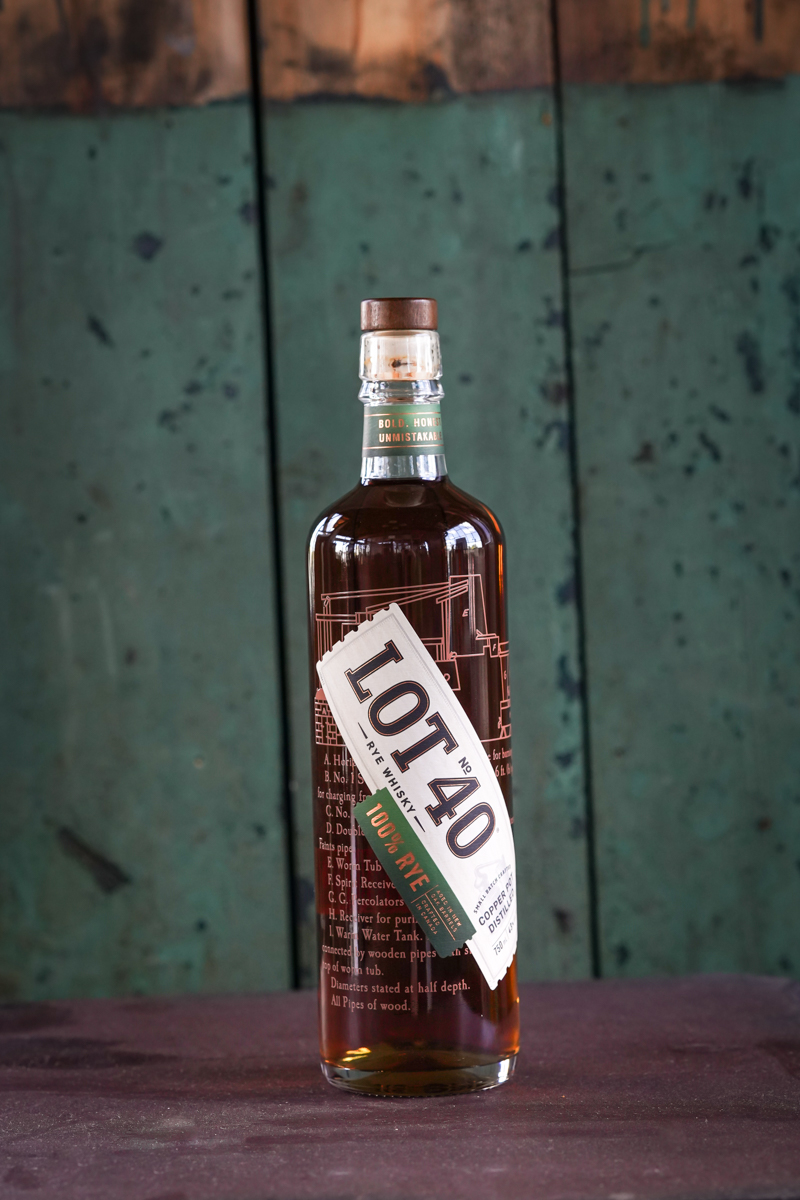Canadian Whisky

Lot 40 is part of a collection called the Northern Border Whiskies, all Canadian whiskies from the Hiram Walker & Sons, characterised by the 100% rye grain used in production.
Canadian whisky is enjoying a resurgence, with the big boys picking up awards for quality while also enjoying a resurgence in micro distilling. As with Irish whiskey, the country deserves a re-appraisal, what with its some deep-rooted history, and that. But what’s that history all aboot?
Well, when the earliest European settlers were arriving, back in the olden days – the 17th century discovered harsh conditions in Canada, it’s frickin’ freezin’ up there. So, despite plenty of practice planting stuff in warmer parts of the world, they struggled to cultivate cereal crops that could survive the cold. Mercifully they discovered rye, which can survive bitter winters, and so, thanks to its tough-guy creds, rye became the go-to grain for the first farmers.
We say they were the first farmers, obviously there were some indigenous people here, successfully working with the land long before the Europeans, but they weren’t making whisky. So we’ll move on.
Perhaps because of this farming history of Canada, which we know you were properly on top of already, many have erroneously associated rye as the dominant grain in Canadian whiskies. True, rye had a vital role in flavouring Canadian even the earliest whisky here, but as it’s not integrally linked to whisky production. As it happens the earliest farmers having a crack at distilling, didn’t really create the first wave of Canadian whisky success – they were moonshiners and they while they distilled with rye, it was for their own amusement and local trade, not for the wider national drinking public.
The first established wave of industrial scale distilling didn’t crash down on the Canadians until the end of the 18th century. Amongst the names found on record is John Grant who actually used molasses to set up rum production in 1786, because rum was far more prevalent than whisky in the early days of North American. It wasn’t until the molasses ran scarce that grains really came to the fore with the likes of John Molson arriving with established distilling knowledge. The Brit might be better known for his brewing, but he also helped introduce industrial distilling to the country in 1799 and came to Canada with and clear ideas on how to make the stuff, understanding the importance of yield and the grains that were easy to distil with.
Molson most likely searched for barley to mimic Scotch and Irish, but as with other distillers of the time, turned to wheat and then found corn more readily available. So, by the early 1800s, Canadian whisky was being characterised by its variety, rather than specifics. Grains now included wheat, corn, barley and where available, that hardy rye for some added spice.
Today, this remains the case, and today, far from the stringent rules that dictate Scotch production, the only regulations in Canadian whisky are that it must contain alcohol distillate made from cereal grain that’s mashed and distilled. It must age in small wood for at least three years in Canada – and that wood can be much more diverse than bourbon, where it’s new American oak. And it must be 40% alcohol by volume. That’s it, so this remains as diverse in flavour as it was when it came into the world.
The only surviving distillery from Canadian whiskey’s pioneering era is Windsor’s Hiram Walker & Sons in Ontario, where Lot 40 is produced today. This brand was founded in 1998 by then-master blender Michael Booth, but it was based on a recipe developed by his seventh-generation forefather Joshua Booth. When Joshua immigrated to Canada, the plot of land given to him was lot number 40, hence the whisky’s name. So there is certainly precedence for rye whisky, and as whisky geeks paw through the pages of distilling history, more evidence of the first moonshiner recipes will undoubtedly emerge.
For now though, Lot 40 remains one element of many in the historic profile of Canadian whisky so if you want an affordable way into the wider flavour story then we recommend tasting the Lot 40 next to few others. At the moment Amazon is doing a price of £34.99 for the Lot 40. From the same stable you’ll find Pike Creek for corn and rye, and Gooderham & Worts, blending corn, rye and wheat.
Share this story
More from Spirit Club
-

Dutch Barn Vodka & Ellers Farm Distillery Tasting
Not content with giving the world puddings, tea, mushy peas (Yorkshire caviar), cricket, the Bronte sisters, Wensleydale cheese, Sheffield FC...
Read more -

Black Forest Martini
Black Forest Martini Capture the spirit of Christmas with the exquisite Black Forest Martini cocktail. This holiday season, savor the...
Read more -

Ellers Farm Distillery: Cherry Liqueur
Indulge in the exquisite taste of our Cherry Liqueur, a delightful blend that bursts with the vibrant flavours of sweet...
Read more

